Iodine and brilliant green rush to the rescue: the secrets of processing cucumbers for a better harvest
Growing an environmentally friendly and healthy crop on your site is not an easy task. Almost all garden crops, including cucumbers, are susceptible to a number of fungal infections.
Some vegetable growers have learned to cope with fungal diseases of plants with improvised means, in particular, with the help of iodine and brilliant green - well-known pharmacy antiseptics. Adherents of these methods believe that with proper processing with brilliant green and iodine, cucumbers are less susceptible to diseases, the defenses of plants increase, therefore, the yield also increases.
The article will tell you whether iodine and brilliant green are really useful for cucumber beds and, if so, how to properly process plants with them.
The content of the article
- Why are cucumbers treated with iodine and brilliant green
- Useful properties of iodine and brilliant green for cucumbers
- How to properly process cucumbers with iodine and brilliant green
- Iodine and brilliant green as prevention
- Important features and differences between processing in the greenhouse and in the open field
- Conclusion
Why are cucumbers treated with iodine and brilliant green
Fungal infections of plants are considered one of the main “garden troubles”. Cucumbers, who love warmth and moisture, are often affected by fungi, mold, root rot.
This is due to waterlogging of the soil, unfavorable weather conditions, a lack of certain trace elements in the soil or its infection with pathogenic pests.
Applying the treatment of cucumbers with solutions of brilliant green or iodine, gardeners protect plants from diseases (late blight, root rot, powdery mildew, etc.).
Cucumber processing is practiced for the following purposes:
- Prevention and treatment of fungal infections.
- Soil disinfection.
Useful properties of iodine and brilliant green for cucumbers
On the agrochemistry market, there are many fertilizers and preparations that protect plants from pests and diseases. They are effective, but traces of them settle in the soil and are present in the fruits, making them less useful and tasty. Solutions containing microdoses of brilliant green or iodine are safe for humans.
Important! Pharmacy preparations: Iodine 5%, 10 ml, and Brilliant green solution 1%, 10 ml, contain alcohol, therefore, they are used for processing plants only in diluted form, strictly following the recommendations below. Overdose can provoke cucumber burns.
Useful properties of iodine
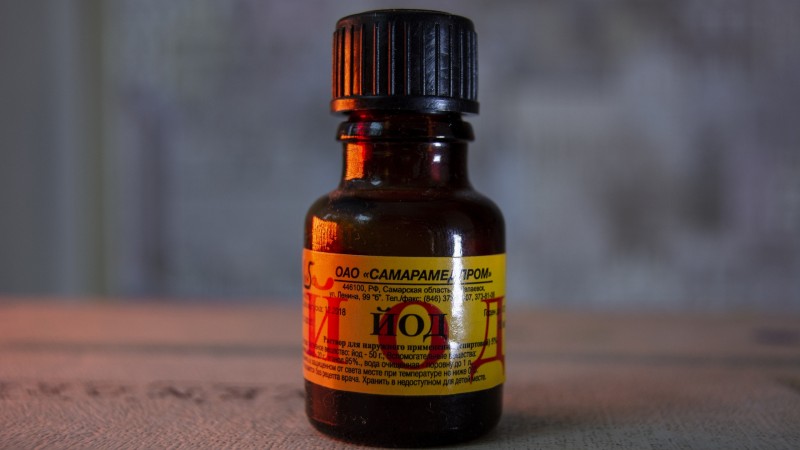
Iodine (I + KI + C2H5OH + H2O) is an antimicrobial and antifungal (fungicidal) agent.
The bactericidal effect of the drug is based on its ability to destroy the proteins of pathogenic microorganisms, disrupting metabolic processes in the cells of parasites and fungi. Iodine is able to prevent viral plant diseases, suppress the development of fungal infections.
A weak iodine solution is an effective means for disinfecting soil in beds and in a greenhouse... It will help get rid of soil pathogens, such as late blight, fusarium, pithium, botrytis, that provoke fungal diseases, root rot, growth retardation and wilting of cucumbers.
The use of iodine in plant growing has become so popular that domestic developers have launched on the market a specialized iodine-based biological product for the treatment of plants and soil - "Pharmayod". It is used for the same purposes as solutions based on a pharmaceutical preparation. The difference is that Pharmayod is an aqueous solution that does not contain alcohol.
Useful properties of brilliant green
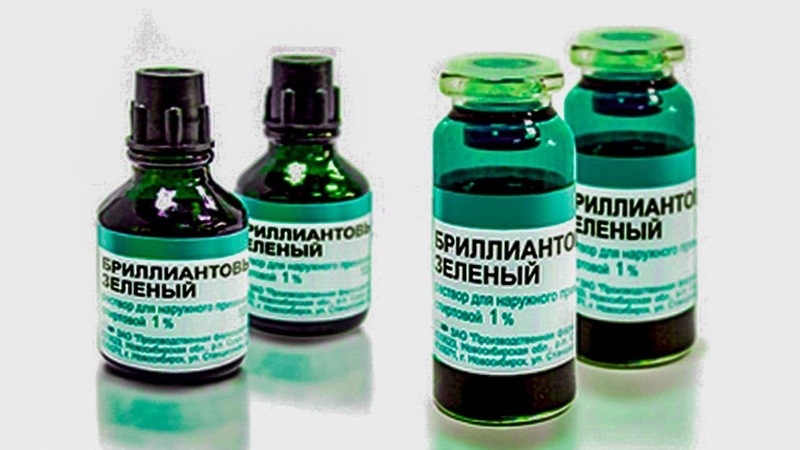
Brilliant green (C27H34N2O4S + H2O + C2H5OH) is a disinfectant and antimicrobial agent. It promotes rapid healing of wounds on human skin, copes with gram-positive bacteria, pathogenic fungi, Staphylococcus aureus and diphtheria bacillus.
Brilliant green has an equally powerful bactericidal effect on plants. A solution based on the drug is an excellent tool that disinfects the soil and destroys the spores of pathogenic fungi.
Mechanical damage to vegetables heals after processing with brilliant green. Before transporting the crop, it is recommended to lubricate all scratches, abrasions and fractures with a solution of brilliant green.
Reference! Brilliant green is incompatible with disinfectants containing active iodine, chlorine, alkalis (including ammonia solution).
How to properly process cucumbers with iodine and brilliant green
For the competent processing of cucumbers with antiseptics, it is important to follow certain rules:
- In order not to be mistaken with the dosage when making the solution, keep in mind that standard pharmacy bottles contain 10 ml of iodine and brilliant green. In a teaspoon - 5 ml, in a tablespoon - 10 ml. The number of drops of the drug required for the solution is measured with an ordinary medical pipette or disposable syringe.
- The water used to prepare the solution should not contain chlorine. Better to use rainwater or settled water.
- Spraying on the leaf is carried out only in the morning or evening in calm weather.
- When processing cucumbers, sprayers with a fine tip are preferred. They create a "cloud" that allows the entire green mass of plants to be irrigated.
- Root watering of cucumbers and soil cultivation should not be carried out on dry ground. Moisten the soil before the procedure.
- After treating the soil with preparations based on iodine or brilliant green, the soil is recommended with live bacteria.

In cases of root rot
Root rot or Fusarium - a fungal disease caused by Fusarium spp. Fungi found in the soil or in infected plant debris.
The infection causes rotting of the root part of the cucumber and develops as a result of a complex of unfavorable conditions:
- Fungus-infested seeds or soil.
- Damp, cool weather.
- Excessive cold watering.
- In the greenhouse: lack of soil cultivation and structure structures at the beginning and at the end of the season; high air humidity due to poor ventilation.
Signs of root rot on seedlings are usually not visible. They appear after transplanting a plant to a garden or greenhouse:
- wilting and yellowing of leaves at the bottom of the stem;
- the stem is thin at the base and has a yellow or brown tint;
- brownish roots;
- fading ovaries.
For treatment, prepare a solution: 10 liters of water, 10 drops of brilliant green. Spray diseased plants every 7 to 10 days.
With severe root damage:
- Prepare a medicine consisting of water and brilliant green, the ratio of ingredients is 2: 1. For example, 20 ml of water and 10 ml of brilliant green.
- With the resulting product, lubricate the affected cucumber stalk from the ground upwards in a 10-15 cm segment.
- Repeat the procedure every 3-4 days until the plant is cured. Experienced gardeners believe that 2-3 such treatments are enough.
For prevention: irrigate cucumbers solution of brilliant green at the rate of 1 drop of antiseptic per 1 liter of water.
Reference! Water rate for irrigation: 4-5 l / m2 before flowering and 9-10 l / m2 during the period of fruit formation. The optimum water temperature for irrigation is + 25 ° C, or not lower than the air temperature.
With white rot

The causative agent of the disease is the fungus Sclerotinia sclerotiorum. It can develop both on the plant itself and in the environment. The spores of the fungus germinate in the tissues of the plant, forming mycelium - a white bloom resembling cotton wool. With the growth of the fungus, new spore-filled fruiting bodies are formed that can spread and infect both plants and soil.
Symptoms of white rot certain, it is difficult to confuse them with other diseases:
- Whitish, "wadded" growths on the whips, leaves, cucumber ovaries.
- Watery, wet spots.
- Withering tips of the shoots.
Prepare a medicinal solution: 10 liters of water, 40 drops of brilliant green.
Spray weekly cucumber lashes and water the soil under the plants and in the aisles.
With gray rot
The causative agent of this bacterial and fungal disease is the fungus Botrytis cinerea, which is found in the soil and plant debris. It spreads by air, insects, birds, garden tools.
Weakened and damaged plants with fractures and mechanical wounds are most often affected.
The appearance of light brown slippery spots on the leaves, stems and fruits of a cucumber are the first signs of gray mold disease.
In the absence of timely treatment, the spots become covered with a fluffy bloom of gray, which indicates the development of the decay process and can lead to the death of the entire plant.
In the fight against the disease, especially at an early stage, one of the solutions will help:
- 10 l. water, 10 ml of brilliant green.
- 10 l. water, 30 drops of iodine, 1 liter of milk whey or milk.
- 10 l. water, 30 drops of iodine, 10 g of boric acid, 1.5 g of potassium permanganate.
It is required to carefully process the diseased plant, soil, as well as plantings adjacent to it every 5-7 days. After 4-5 procedures, the condition of the plants will improve.
With powdery mildew
Powdery mildew, or an ashtray, or linen - a fungal disease that is provoked by microscopic ectoparasites. It is a common cucumber disease that affects plants in early summer.
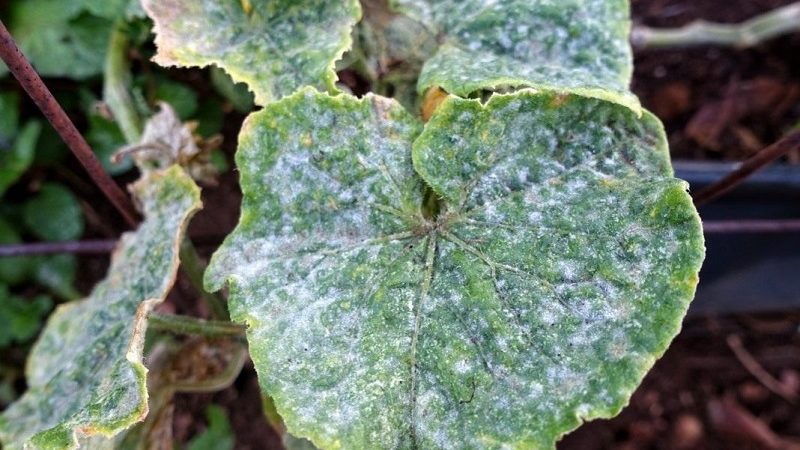
First, white spots appear on the leaves and young shoots - this is the mycelium of the fungus. Later, after the maturation of the spores, the spots become covered with drops of liquid, similar to dew - hence the name of the disease.
Leaves located close to the ground are primarily affected, since the spores of the fungus live in the upper layer of the soil. Gradually, the infection spreads to the entire plant, leaves and stems wither and dry out.
One of the medicinal solutions will help:
- 10 l of water, 10 ml of brilliant green, 2 l of milk serum, 40-50 g of urea.
- 5 l. water, 2 tsp. soap, 10-12 drops of iodine, 500 ml of milk whey.
- 9 liters of water, 1 liter of low-fat milk, 10 drops of iodine or brilliant green.
For preventive purposes: 2 liters of milk, 10 ml of brilliant green or iodine. The solution is used to cultivate the ground under cucumbers, after moistening it. The solution should not get on the green parts of the plant.
Diseased plants should be treated at intervals of 7-10 days; for disease prevention - 3 times per season: before flowering, after flowering and 10 days after the appearance of the first ovaries.
Downy mildew, or Peronosporosis
This disease is more transient and dangerous. It is better to carry out preventive measures than to deal with an insidious disease. The solution consists of 8 liters of water, 2 liters of milk whey and 10 ml of brilliant green.
Preventive spraying is carried out 3 times per season: before flowering and twice more with an interval of 7-10 days.
Against late blight
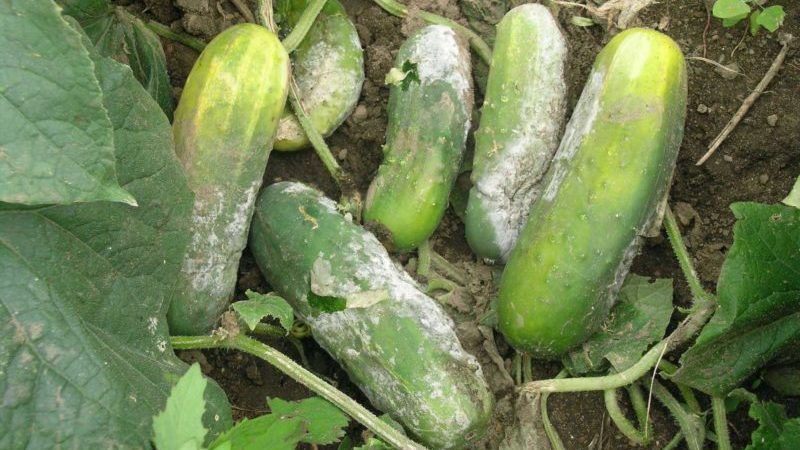
The causative agent of the disease is a genus of lower parasitic fungi Phytophthora. The fungus lives in the soil, settles on the roots and aerial parts of the plant.
Phytophthora loves moisture and warmth, the spread of the disease is also facilitated by an overly dense planting of cucumbers. The consequence of the disease is rotting, drying out and wilting of the plant.
The first signs of the disease are the appearance of small brownish-brown spots on the leaves of cucumbers. On the underside of the leaf there is a barely noticeable white spider web. If treatment is not started on time, the affected leaves turn yellow, curl and fall off. Fruits are also covered with brown specks of rot.
Treatment should be started at the first sign of illness. First of all, you need to cut off the leaves affected by the fungus, and then treat the plants with a medicinal solution: 10 liters of water, 20 drops of brilliant green or 20 drops of iodine.
Irrigation should be carried out in the evening, the interval between treatments is 4–5 days.
To cure late blight will require 2-3 such treatments.
Iodine and brilliant green help well at the initial stage of the disease, but if the disease is started, then the use of chemicals (HOM, Oxykhom, etc.) will be required.
It is more correct to carry out preventive treatment of plants from this insidious disease.
To do this, you need to prepare a solution: 9 liters of water, 1 liter of whey or skim milk, 2 ml of iodine. Treat 1-2 times at weekly intervals.
Iodine and brilliant green as prevention
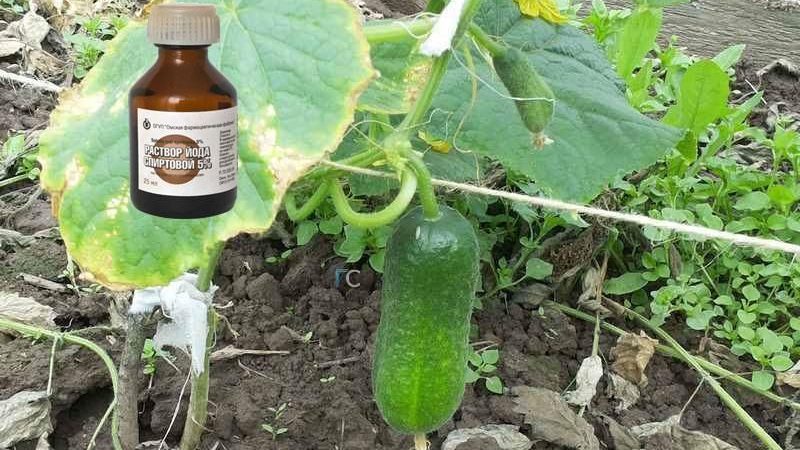
Treatment of cucumbers with folk remedies, including using brilliant green or iodine, gives lasting results. However, it is better to carry out preventive measures and prevent infection of plants with dangerous fungal diseases.
Prevention begins with seed treatment. An effective agent that disinfects seeds is an iodine solution (1 liter of settled water, 1 drop of iodine), which is used to moisten a piece of gauze and place seeds in it for 6-8 hours. Then the seeds are dried and used for their intended purpose - for planting on a garden bed or in a seedling container.
Before transferring seedlings to a garden bed or greenhouse, it is advisable to spill the soil with a weak iodine solution: 10 liters of water, 3 drops of iodine.
Intense rainy weather or excessive heat provokes the development of cucumber root rot. Low concentration iodine solution will protect plants and prevent disease: 10 l of water, 1 ml of iodine. Each bush is shed under the root, spending 1 liter of solution per plant.
For the prevention of powdery mildew, late blight, white and gray rot of cucumbers, it is advisable to use a different method - foliar spraying of stems and leaves. The purpose of the event is to disinfect, "burn" cucumber leaves and whips and prevent the development of pathogenic organisms on them. For processing, a solution is used: 10 liters of water, 5-10 ml of brilliant green.
To disinfect the soil, use the following solution: 10 liters of water, 10 drops of brilliant green. The soil is spilled three times per season: at the stage of the fourth leaf, at the beginning of flowering, after the appearance of the first ovaries.
Attention! Any processing is stopped one week before harvest.
All recipes using brilliant green and iodine contain minimal doses of drugs that cannot harm human health. Moreover, those micrograms of iodine that can settle in fruits will not be harmful, but, on the contrary, are useful to residents of central Russia living at a considerable distance from the sea.
Important features and differences between processing in the greenhouse and in the open field
Cucumbers grown in the greenhouse and in the open field are in different conditions of light, air temperature and humidity. Therefore, there are some peculiarities in caring for them.
In the greenhouse
In a greenhouse where the air humidity is high, with insufficient ventilation and excessive watering, the likelihood of root rot is high. Therefore, special attention is paid to preventive treatment against root rot. Irrigation with antiseptic solutions, root cultivation and soil cultivation are shown.
Remember that processing in the greenhouse is carried out only in the morning, because at night, when the air temperature in the greenhouse decreases, humidity increases and condensation forms. Evening spraying will aggravate the situation and create preconditions for the development of pathogenic fungi.
Treatment with an iodine solution in a greenhouse is carried out less often than in open ground in order to avoid excessive concentration of the agent in the soil.
In the fall, at the end of the season, it is recommended to replace the fertile soil layer in the greenhouse, and then treat all greenhouse structures and the ground itself with iodine solution.
Attention! When irrigating plants and soil in the greenhouse with solutions containing iodine, it is recommended to protect yourself by wearing a respirator and goggles. Processing must be carried out with open doors.
In the open field
The health of cucumbers growing in open ground largely depends on weather conditions: prolonged rains contribute to waterlogging of the soil, heat - drought, the wind carries and spreads infections.At the first signs of illness, adequate measures must be taken immediately.
Remember that it is recommended to irrigate cucumbers outdoors in the morning or evening, in the absence of direct sunlight, in dry and calm weather.
Conclusion
Many vegetable growers successfully use such simple and effective preparations as brilliant green and iodine when growing cucumbers. They are cheap and available, and are used in small quantities for processing plants.
On household plots, medicinal solutions based on iodine and brilliant green are used not only for growing cucumbers, but also for improving the growth and development of many other vegetable crops.